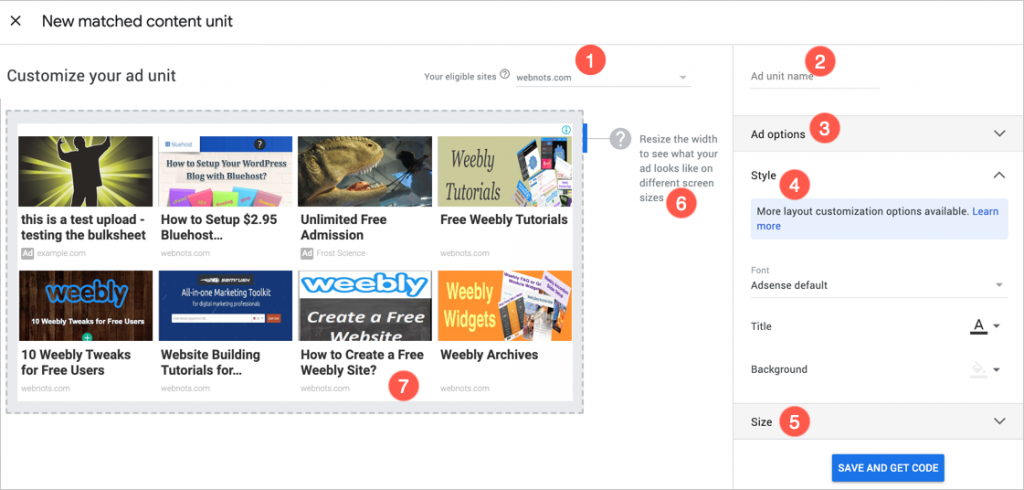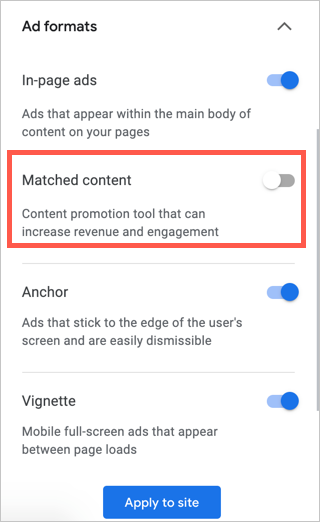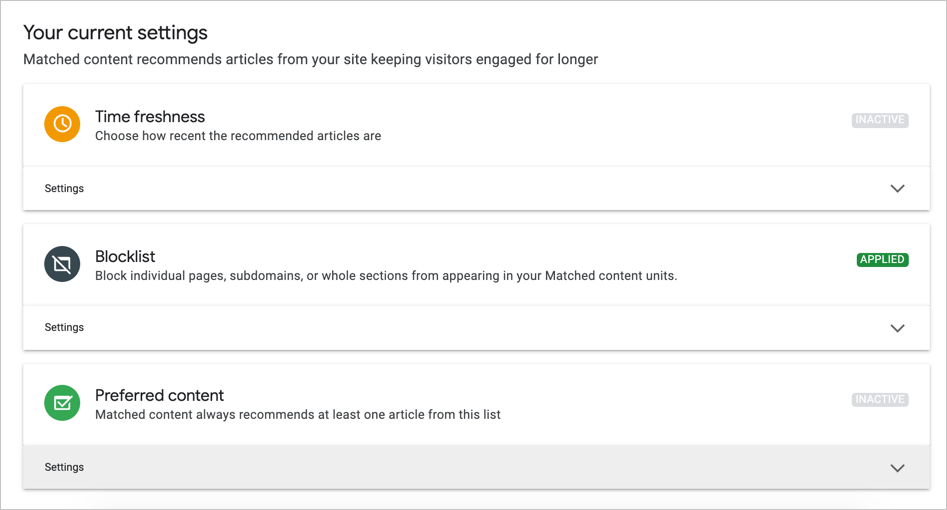What is AdSense Recommended Content?
In April 2015, Google introduced a content recommendation widget through its existing AdSense platform. This is similar to articles recommended by outbrain or taboola and indicates Google’s intent to enter this area of content recommendation for monetization. This widget is also comparable to the related posts widget in WordPress and other CMS platforms. The widget will look something like the one shown below and will quickly take up container space.
The purpose of the featured content widget is to increase page views, thereby indirectly increasing ad revenue. In addition, you can also choose to show ads to earn more income.
Who is eligible?
Unfortunately, matching content ads are not available to all AdSense publishers. Google states that eligibility is subject to a minimum traffic limit and the unique pages available on the site. Of course, this ad format is also only applicable to AdSense publishers who own approved websites and other products such as AdMob or YouTube. You can check eligibility for your AdSense account:
- Sign in to your AdSense account.
- Go to Sites > Featured Content.
- You will see a list of eligible sites, as shown in the image below:

- If you only have one site in your account and are not eligible to show ads with matching content, you won’t see the “Recommended Content” menu in the “Sites” section.
- If you have multiple sites, you’ll only see eligible sites in the “Recommended Content” section. Other sites are not accepted in this case.
Remember that ads with relevant content work at the domain level. If you have subdomains or subdirectories, the content recommendation will also include pages from those sites. However, you can use the blacklist feature to block or enable certain pages on your site.
How do I create ads with featured content?
If you have a suitable site in your account, there are two ways to generate content recommendations. One is to create a standalone ad unit, the other is to use the auto ad feature.
Create an ad unit with featured content
We recommend creating a separate ad unit, as auto-ads can ruin your site’s display. After logging into your account, go to “Ads > Browse > By ad unit”.
The process is the same as for creating any other ad unit, in which case select the Relevant Content option. On the next page, you can see a display of recommendations for the content of your site with options for customization.

- Select eligible sites from the list to view recommendations in the preview panel.
- Enter a unique title for your ad.
- Ad Options – Choose whether you want to monetize your recommendations. We will explain this in more detail below.
- Style – Customize the font, title color, and background color for the ad area.
- Size – You have two options to choose from – adaptive and custom. If your site does not have a container of a specific size, we recommend choosing the Responsive option. If you want to use the “Custom” option, Google recommends using the width to height ratio as 2:1 for horizontal placement and 1:2 for vertical placement.
- In addition, you can also drag the slider to resize the ad area to adjust the ad size.
After completing the settings, click the “SAVE AND RECEIVE CODE” button. Copy the code snippet and paste it on your site to serve ads with relevant content. It may take a while for Google to show ads on your site, so wait 15-30 minutes to check if everything is in order.
Using AdSense auto-ads for featured content
Creating a separate ad unit will help you place the code in the desired location. Typically, recommendations can be placed below the content or inside the sidebar area. However, this can be a difficult task if your site has a different structure on different pages. In this case, you can allow Google to automatically serve ads with matching content through automatic ad settings.
- Once you’re on your AdSense account page, select “Ads > Browse > By Site”.
- Click the Edit icon next to the appropriate site. This will show a preview of the automatic insertion of ads on the selected site.
- On the right sidebar, enable the “Relevant Content” option under “Ad Formats”.

Click the Apply to Site button to enable matching content recommendations. As mentioned, auto ads can insert content recommendations below the footer area. In most cases, users will not see ads available under the footer. Therefore, we recommend that you use separate ad units with suitable content to show in your preferred section of your site. However, the big benefit of auto ads is that you can enable the AMP option to have it show up on AMP pages.
Further customization of featured content
Google allows you to modify the ad code of the respective content to change the format, row and columns. You can refer to the Official Google Support Page to get the recommended code to change the display to suit your needs. However, you can set up content recommendations in your AdSense account. Go to the “Relevant Content Sites” section and click the relevant site. You have the following customization options:
- Freshness of the time – choose content to display at any time or only the most recent recommendation article.
- Blacklist – You can block any specific page, subdomain or subdirectory. This is useful for excluding recommendations from subdomains when you have unrelated content on the domain and subdomains.
- Featured Content – You can permanently add any specific page to your site based on recommendations. Google will show you the page in the list regardless of the content on the current page. This will be useful for driving traffic to any specific page on your site.

Can I make more money from featured content ads?
The ideal goal of matched content ads is to improve user experience, page views, and time spent on site without directly impacting AdSense revenue. Since more page views will lead to an increase in RPM and the potential for more ad clicks, there is a high chance of increasing revenue from ads with relevant content.
While it is offered as a free recommendation tool, the purpose it offers as part of an AdSense account is inevitable and Google will convert it into a monetization option sooner or later. . As we mentioned earlier (crossed out), you can now easily monetize content recommendations on your site. Even at this point, sponsored ads are displayed between the respective featured posts, indicating that Google may be experimenting with this feature in beta mode. Google constantly optimizes matched content ads and allows you to add content sponsored by third parties to your site. You can use a special meta tag to tell Google that youshowing sponsored content inside matching recommendations .
What are the rules?
Because the purpose of matched content ads is different, they have a different set of guidelines:
- Make sure that ads with matching content are only placed on the right site, placing them on another site may not display recommendations and the recommendations will only work at the domain level.
- The Recommended Content widget will only display pages with an AdSense ad code (regular ad or ad with relevant content).
- Ads with matching content will not count against the page-level content ad limit. While there is no limit to the number of ads with matching content on a page mentioned by Google, it makes sense to limit the number of ads to a maximum of two widgets.
- Google recommends placing the widget either above or below an AdSense ad or below the content of a post to increase user engagement.
- The widget is responsive and also works on mobile devices.
Pros and cons
There are many advantages and disadvantages to using AdSense ads with relevant content on the page.
Minuses:
- The widget has very limited controls, for example the page must have a displayable image and open chart meta tags in order for Google to display the images.
At the moment, there is no option to select text-only recommendations.You can change the code to only use text recommendations if you don’t have suitable images on all pages of your site. - Because the recommendations use a script, users can block ads using ad blocking software. Also, if Google services are not available, an empty space will be displayed in the associated content widget.
- Earnings per click from ads with matching content is only $0.1, which may not make sense if you have a large site.
- Ads with overlapping content will drastically reduce your page load speed as images and scripts need to be downloaded from third party servers.
Pros:
- Works in your AdSense account regardless of platform.
- Increases the opportunity to generate more revenue from existing content on the site.
- Related posts widgets are resource intensive because all posts must be indexed before getting the corresponding posts based on title or tags. Ads with matching content are rendered relatively asynchronously without impacting server throughput. This is especially useful when using cheap shared hosting servers.
Monitoring Performance Reports
One of the biggest benefits of using matched content ads is that you can easily track and get ready-made reports from the performance reporting section of your AdSense account. There are three metrics available for this report – total impressions, recommendations, and clicks, as shown in the figure below:

You can also create a related content report and track revenue.
Conclusion
AdSense is a powerful monetization option for website owners, and ads with relevant content certainly represent an added value for existing publishers. We also hope that Google exits beta mode soon and offers more customization options or plugins for platforms like WordPress. . Google now has a SiteKit Plugin to integrate all Google tools like Analytics, AdSense, PageSpeed and Search Console into your WordPress site.
The crossed-out content was written at the time of the original publication of this article. As we expected, Google has adapted all the changes, such as integration with WordPress, allowing monetization and customizing the display.